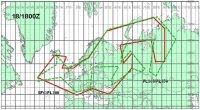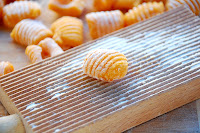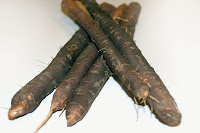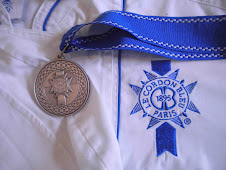A few days ago I asked you for some ideas for my upcoming workshop. I received quite a few replies, thank you very much for that and it certainly gave me some good ideas. I did have a few sleepless nights over it... The chefs told us numerous times that we should keep it simple (and French probably) and respect the ingredients. Some things go together, some things don't.
I explained the rules before in an earlier blog entry; click
here for those details.
On Wednesday, I went to
Simon, the cookery shop, to have my knives sharpened. Just mention that you're from Cordon Bleu and mention the name of chef Terrien, and everything is for free. C'est formidable ! But..... the machine was 'en panne', broken down, so I had to go back the next day. So I brought 7 knives to sharpen.... ze man in ze shop was not 'appy....
So, to cut a long story short, I came up with the following menu:
My starter, two identical plates.
Chartreuse de saumon et gambas, mayonaise de poivron rouge, un salade aux herbs avec une vinaigrette de échalotes.
My main course:
Pigeonneau avec une glace de porto/miel, pommes de terre farci avec duxelles et cougette, oignons grelots glacée et tomate avec petit pois. Isn't that crappy French, or what!?
Yes, the bird is dead now!
Some details: I cooked the salmon (just put it in the oven at 150degC for some time, no oil, until done - don't overcook!), fry the shrimps and chop up (keep one for decoration). Mix the shrimp well with the salmon and cool off.
Make a mayonaise (egg yolk, mustard,salt/pepper, vegetable oil - no olive oil, that's too strong, whisk like hell, add lime juice and some 'jus' from the red bell pepper to give it some colour. Check seasoning all the time.
Use bit of mayonaise in the salmon/shrimp mixture to bind it properly and make it more smooth. Put all of it in a plastic piping bag.
The chartreuse: Using a mandolin (I bought one!) slice thin layers of carrot, red bell pepper (skin off) and leek. Blanch all separately, cool and pat dry. Then, cut into nice strips. Line a mould with clingfilm and 'coat' the inside with the strips of carrot / leek / red bell pepper all around. Finally, using a piping bag, fill the chartreuse with well seasoned salmon/shrimp/mayo mixture and keep cool in the fridge.
Presentation: Chartreuse, herb salad with a shallot vinaigrette and mayonaise on the side. Decorate the plate with some paprika powder.
I was ready with my starter at 10.15, which was bloody early, but I didn't want to plate first, so I waited a bit until 11.15 after 1 or 2 others presented their dishes to chef. I guess I was a bit scared.... don't know.
Chef really liked this one. It was colourful, I used different techniques and above all, the taste was good. I was really happy with it.
My main course was pan-fried pigeon breast, served pink, with a porto/honey glaze, a stuffed potato with duxelles and tiny sprigs of courgette sticking out, some glazed pearl onions and a (hollow) tomato with peas inside. And a nice pigeon sauce around the breasts. All well seasoned and served on a hot plate.
This one was OK, not really spectacular, but OK/good. My pigeon was slightly overcooked and I should have served the peas in the tomato as a puree inside it, not as whole peas. (And I did some therapy during the atelier - I shelled the peas AND I took the skin of the things.... )
All in all, quite an adventure. And please don't forget, this was the first time ever we've done it like this. So, next time the dishes will be more professional and colourfull etc., I hope! I really really liked doing it. Actually, if we can do this every other week or once every 3 weeks, I'd really like that. I've learnt a lot from this. And thank you chef Franck Poupard for supervising and helping us out to get more ingredients when needed!
One of the nicest things in class was that everyone did something completely different. Some did a starter with the pigeon, some made a carpaccio of the salmon, some deep-fried a lot. Well, there were so many different dishes, so here is a selection of the starters we've made in this atelier. (I will not post any names with the pictures and it's in random order. Nor will I put any comments with it.)
I'll post a few of the main courses on the next blog entry.
Sjoerd








